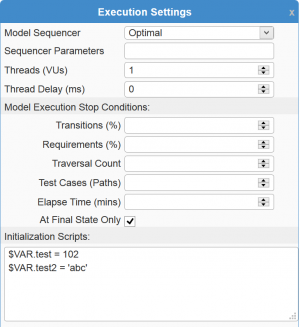Table of Contents
Tutorial: Load Testing with Runtime Servers
Learning Objectives:
Virtual Users (VUs)
Virtual Users (VUs) is an important concept in load testing and stress testing with each VU representing one testing session.
In TestOptimal, VUs are implemented with separate processes (threads) to execute the test cases generated from the model.
A model is executed with one or many VUs. In the web application / website load testing, VU is used to simulate concurrent users.
Unlike typical load testing tool which submits pre-designed http packets or scenarios, TestOptimal can re-purpose models to dynamically generate test cases with the help of sequencers to simulate the more realistic production load on the system.
Model Execution with VUs
When you execute a model, it uses one VU by default. You can change the number of VUs to be used for model execution in the Execution Settings:
Set the field “Threads (VUs)” to the number of virtual users you wish to simulate running your AUT.
You can also change how fast you want to ramp up the VUs by setting the “Thread Delay (ms)” before starting next VU.
For load / stress testing, typically you will want the model and all of its VUs to be running for a desired period of time. You can do so by setting “Elapse Time (mins)” in “Model Execution Stop Conditions” section before running the model.
When running the model with IDE, be sure to select “Random” sequencer such that the model will be traversed randomly to simulate realistic user behavior while still maintaining validity of the test scenarios as described by the model.
Multi-model execution
Each model describes a set of behavior (requirements, user stories) of AUT. By running the model, we are exercising and checking those behavior.
If you have more than one models created to test your AUT, you may want to run these models concurrently to expose your AUT to various types of activities described by these models.
You can do so by opening each model and run the models (with 1 or more than one VUs). As you open another model, be sure do not close the previous model.
Load testing with multi-browser
Selecting which browser to use to run load testing is done in the scripts, for example:
$SELENIUM.setBrowserFirefox();
You may replace above script with the following to randomly choose a browser to run the testing for each VU:
$SELENIUM.setBrowser ('Firefox|IE|Chrome');
If you wish to have more “Firefox” users, you can just list “Firefox” twice or three times, for example:
$SELENIUM.setBrowser ('Firefox|Firefox|IE|Chrome');
If you run the models through SvrMgr or use API to run models on Runtime server, you may select browser from a variable that is specified in the model execution request:
$SELENIUM.setBrowser ($VAR.browserList);
where “browserList” variable is set in the model execution request options.
Load testing with Runtime Servers
To generate a lot of load on AUT, you may need to run many instances of TestOptimal servers, which makes it harder to manage and control the load testing session.
Runtime server is a licensed edition of TestOptimal server that can be managed by SvrMgr for large scale load / stress testing.
SvrMgr also provides a central model deployment repository and model execution stats collection for all Runtime servers.
Runtime servers can be running on different OS or even on the cloud.
By using TestOptimal REST APIs, you can also build a concurrent model (model that uses Concurrent sequencer) to orchestrate model executions on Runtime servers (via SvrMgr) and thus automate your load testing by simply running the orchestration model.
Load testing with cloud-based services
There are cloud-based testing services for web application testing. These cloud-based services offers an alternative to managing different OS and browser and even mobile device testing.
Below is a few example of such services:
To connect to these services, you would use WebDriver plugin using the APIs provided by the online service provider.
Simulating production load
The first step in load testing is to determine the type of loads and how much you wish to exercise on AUT. Typically you would already have suite of models created for functional testing of AUT. These models when executed generates a specific type of loads on AUT.
Carefully select a subset of these models that will generate the type of loads required and determine the number of virtual users for each selected models. You may use the following example to help you plan your next load testing:
Model Nam MCase VUs Run Duration (min) Thread Delay (ms) WebStore Security 20 60 15000 WebStore Main 300 120 5000 WebStore Main Quick Purchase 50 60 10000 WebStore Main Add/Remove Items 20 60 10000
Note that in the above example, we are using two models:
- WebStore Security - security testing for user registration and valid / invalid logins.
- WebStore Main - main functional testing of WebStore application
We also plan to run certain scenarios (MCases) during the load testing.
